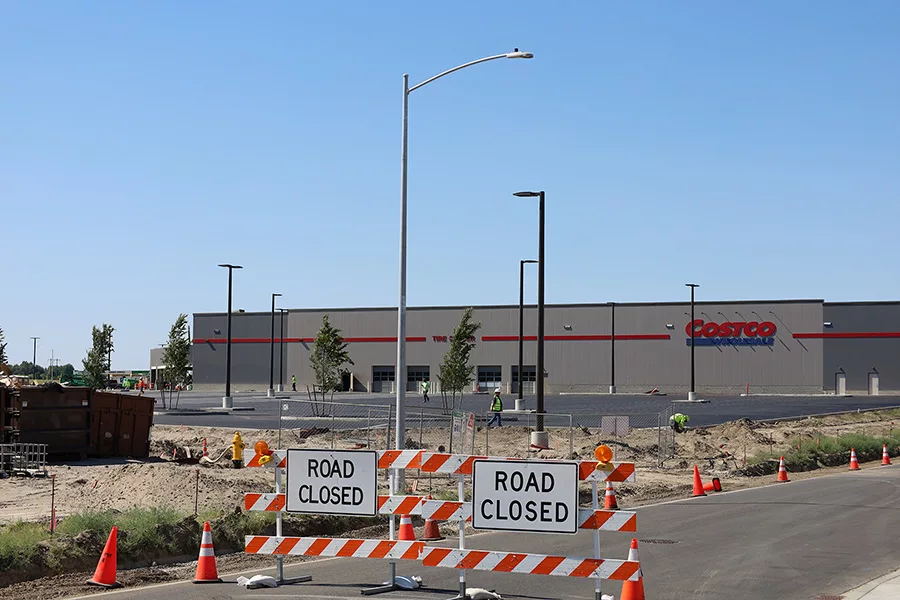
Home » Tri-City housing, commercial sectors reflect a tale of two markets
Tri-City housing, commercial sectors reflect a tale of two markets

Numerous commercial developments, from retail to industrial, are in various stages of development or nearing completion around the Tri-Cities, including the Richland Costco store off Duportail Street near Target and Walmart.
Photo by Nathan FinkeJune 12, 2025
It’s a tale of two markets when it comes to residential and commercial properties in the Tri-Cities so far in 2025.
Numerous commercial developments, from retail to industrial, are in various stages of development or nearing completion, Kirt Shaffer with Tippett Company told the Tri-Cities Area Journal of Business. And new spaces are filling up.
“I have the highest levels of general inquiries from tenants and tenant brokers,” Shaffer said. “We have gobs of interest that is on my list.”
The residential market, whether it be existing homes or new construction, is another story.
Building permits for single-family homes through April are down 22% and $25 million in total value. The 321 homes sold in May is the second lowest sold amount in that month since 2014 and the number of homes sold through the first five months of the year is the second lowest since 2014 as well.
“From the builders’ perspective, from the consumers’ perspective, the anxiety that is being portrayed across the country is definitely being felt here,” said Jeff Losey, executive director of the Home Builders Association of Tri-Cities.
The Tri-Cities have seen relentless growth in recent years, buoyed by the region’s stable economy and relatively affordable housing compared to the rest of Washington state.
But Losey said that’s not coming to bear this time. High interest rates, the effect of tariffs on building materials and anxiety over proposed budget cuts at the Hanford site are weighing on sellers, buyers and builders alike.
And there’s no indication of when things could stabilize. Currently, there’s a 14% tariff on lumber from Canada, which many builders rely on, Losey said. But the Trump administration has signaled those could increase to 20% or 30% in the fall, which has fed into an abnormally slow start to the busy construction season, he said.
“There’s nobody right now that wants to have too much capital sitting out there,” Losey said. “Builders are being cautious about how many starts they’re working on.”
Andrew Magallanez, CEO of the Tri-City Association of Realtors, told the Journal that this spring has been slower than in the past but the seasonal uptick is materializing. He isn’t seeing as many signs that buyers are sitting on the sidelines, nor that sellers are waiting things out.
The inventory of active listings hit 944 in May, the highest level since December 2014, though that is still below the 1,200 to 1,300 active listings that housing experts have said are needed to properly meet demand.
“I think people are starting to realize interest rates are what they are,” Magallanez said. “This is the new normal.”
Both Magallanez and Losey said the rent control legislation recently signed by Gov. Bob Ferguson will have an impact, though how is yet to be seen. Magallanez thinks that it could be why more homes have entered the market.
“A lot of the smaller mom-and-pop landlords, that maybe own one or two units, are getting out,” he said.
Losey said he sees rent control further hindering people from becoming homeowners. While the new law prevents rent increases above 10% per year, he suspects that landlords and property management companies will raise rents that much more consistently year-to-year instead of adjusting them to market demand, which would mean years with minimal if any rent increases.
And he agreed with Magallanez that it will affect the housing supply.
“We’re already hearing that there are guys that had projects they would have done and considered but now they’re looking at other states. It ties their hands,” Losey told the Journal.
For non-residential projects, though, the situation is rosier. Shaffer said light industrial so far in 2025 was a little slower than for the same period in 2024, but still above the 10-year average.
There are some pauses on projects, namely for businesses tied to construction supply or those based overseas, due to tariffs. But there’s a sense that things will stabilize later in the year so they are being patient, Shaffer said.
Interestingly enough, Shaffer said, he’s seeing more office spaces finding tenants. Those have seen high vacancy since the Covid-19 pandemic when remote work was widely adopted. The recent push to bring employees back into offices, as well as the fact that office operations are less impacted by tariffs, have likely led to that development.
Retail isn’t moving as quickly, but new properties are coming onto the market and others are being absorbed. And all of that activity is spread across the area.
“Retail is just all over the place, which I think is a good thing, gives a lot of choices,” Shaffer said.
Real Estate & Construction Local News Mid-Year Economic Review
KEYWORDS June 2025
Related Articles
Related Products





